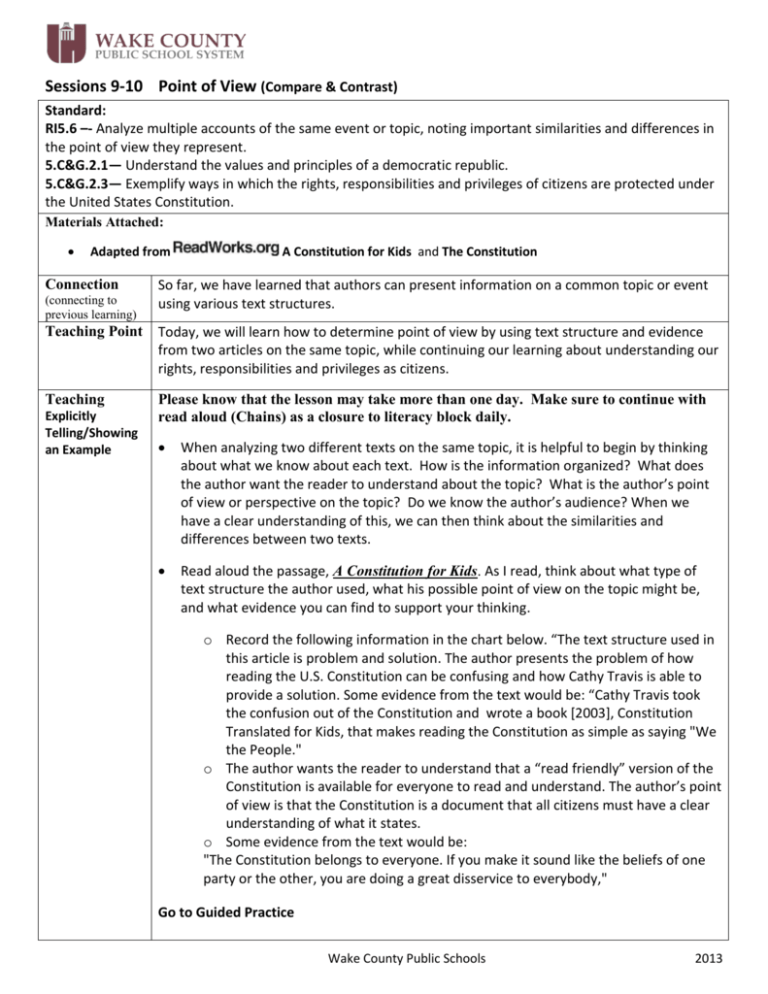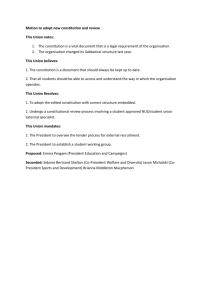
Sessions 9-10 Point of View (Compare & Contrast)
Standard:
RI5.6 –- Analyze multiple accounts of the same event or topic, noting important similarities and differences in
the point of view they represent.
5.C&G.2.1— Understand the values and principles of a democratic republic.
5.C&G.2.3— Exemplify ways in which the rights, responsibilities and privileges of citizens are protected under
the United States Constitution.
Materials Attached:
Adapted from
Connection
(connecting to
previous learning)
A Constitution for Kids and The Constitution
So far, we have learned that authors can present information on a common topic or event
using various text structures.
Teaching Point
Today, we will learn how to determine point of view by using text structure and evidence
from two articles on the same topic, while continuing our learning about understanding our
rights, responsibilities and privileges as citizens.
Teaching
Please know that the lesson may take more than one day. Make sure to continue with
read aloud (Chains) as a closure to literacy block daily.
Explicitly
Telling/Showing
an Example
When analyzing two different texts on the same topic, it is helpful to begin by thinking
about what we know about each text. How is the information organized? What does
the author want the reader to understand about the topic? What is the author’s point
of view or perspective on the topic? Do we know the author’s audience? When we
have a clear understanding of this, we can then think about the similarities and
differences between two texts.
Read aloud the passage, A Constitution for Kids. As I read, think about what type of
text structure the author used, what his possible point of view on the topic might be,
and what evidence you can find to support your thinking.
o Record the following information in the chart below. “The text structure used in
this article is problem and solution. The author presents the problem of how
reading the U.S. Constitution can be confusing and how Cathy Travis is able to
provide a solution. Some evidence from the text would be: “Cathy Travis took
the confusion out of the Constitution and wrote a book [2003], Constitution
Translated for Kids, that makes reading the Constitution as simple as saying "We
the People."
o The author wants the reader to understand that a “read friendly” version of the
Constitution is available for everyone to read and understand. The author’s point
of view is that the Constitution is a document that all citizens must have a clear
understanding of what it states.
o Some evidence from the text would be:
"The Constitution belongs to everyone. If you make it sound like the beliefs of one
party or the other, you are doing a great disservice to everybody,"
Go to Guided Practice
Wake County Public Schools
2013
Guided Practice
(3-5 minutes)
Have students
practice the strategy
that has been
demonstrated.
Link
Direct students to
apply the
demonstrated
strategy.
Read Aloud
With a partner, read the article, The Constitution.
As you read, think about what type of text structure the author used to organize the ideas
presented. Then discuss with your partner what you think the author wants you to learn
and his/her point of view on the topic.
Record your responses in the chart provided.
As you read expository texts on a common topic, think about the structure of the text, the
author’s point of view and how that impacts what the author wants you to learn.
Continue to read Chains to students in the classroom, making sure to provide the background
knowledge to help students comprehend the text. The read aloud for this unit is completed at the
end of literacy block as the focus of the mini-lessons support expository text. However, the purpose
to reading Chains during this unit is to bring history alive for your students by letting them see
history through the eyes of the people who might have experienced it.
Wake County Public Schools
2013
A Constitution
for Kids
The Constitution
How is the
information
organized?
What does the
author want the
reader to
understand about
the topic?
What is the
author’s point of
view or perspective
on the topic?
Wake County Public Schools
2013
A Constitution for Kids
Sometimes reading the U.S. Constitution can be confusing. Most people
1
2
can’t tell their habeas corpus from their ex post facto .
In 2003, Cathy Travis took the confusion out of the Constitution. Travis,
who works as a congressional aide in Washington, D.C., has just written a
book [2003], Constitution Translated for Kids, that makes reading the
Constitution as simple as saying "We the
People."
The 85-page book has the original text of the
Constitution on one page and Travis’s
3
translation on the facing page.
For example, article 1, section 9, clause 3, of
the Constitution reads: "No Bill of Attainder
or ex post facto law shall be passed."
Travis’s translation: "Criminal laws passed by Congress can be applied only
from the time they are passed."
Travis said she got the idea to write the book when Ross Perot ran for
president in 1992 against George H. W. Bush and Bill Clinton. She became
angry every time Perot made statements about the Constitution that she
considered inaccurate.
Travis said she took great care to make sure that her translation of the
document was fair and accurate. Many aspects of the Constitution are open
to debate.
"The Constitution belongs to everyone. If you make it sound like the beliefs
of one party or the other, you are doing a great disservice to everybody,"
Travis told the Austin-American Statesman.
1
habeas corpus: a legal order to find out if a person has been wrongly sent to prison
2 ex post facto:
after the fact; retroactive
3 translation: expressing text in a different language (in this case more
easily understandable English)
Adapted from
Text: Copyright © 2007 Weekly Reader Corporation. All rights reserved. Weekly Reader is a registered
trademark of Weekly Reader Corporation. Used by permission.
© 2010 Urban Education Exchange. All rights reserved.
Wake County Public Schools
2013
The Constitution: The Forgotten Amendment
Most educated people of the eighteenth
construed to deny or disparage others retained
century, such as the Founding Fathers,
by the people. Meaning in simpler language,
supported the idea of Natural Rights Theory.
that certain rights listed in the Constitution
Meaning every human has a considerable
shall not mean that other rights of the people
number of natural rights, because they are a
are denied.
human person.
Today, two views are held as to what this
When the US Constitution was sent to the
amendment really means. One view is that all
states for ratification or approval, many people
rights have been included in the Constitution
at that time felt that the federal government,
and anything not listed is just present in our
according to the Constitution, would be too
lives and traditions. The other view holds that
strong. They were concerned that rights of
the language of the Ninth Amendment allows
individual citizens versus the government were
for rights the Founding Fathers couldn’t have
not clear enough.
imagined in their time such as a woman’s right
This led to the creation of the Bill of Rights,
which are the first ten amendments.
They
were ratified or approved by the states at the
same time as the Constitution. The first eight of
these amendments list specific rights of
citizens, but some leaders feared that listing
some rights could be misunderstood to mean
that citizens didn’t have other, unlisted rights.
To help with this possible misunderstanding,
to vote.
So far a majority of the Supreme Court has not
agreed with either interpretation, preferring to
ignore the Ninth Amendment altogether. As
such, most Supreme Court cases use other
amendments when making their final rulings
and why many scholars call it the forgotten
amendment.
James Madison and others produced the Ninth
Adapted from The Words We Live By-Your Annotated
Amendment, which states: The enumeration in
Guide to the Constitution by Linda R. Monk
the Constitution, of certain rights, shall not be
Wake County Public Schools
2013









